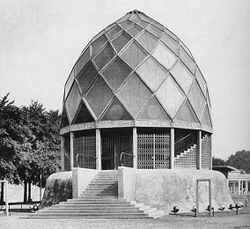Werkbund Exhibition (1914)
- Werkbund Exhibition (1914)
-

Bruno Taut'
s Glass Pavilion
The first Werkbund Exhibition of 1914 was held at Rheinpark in Cologne, Germany. Bruno Taut's best-known building, the prismatic dome of the Glass Pavilion of which only black and white images survive today, was in reality a brightly colored landmark. Walter Gropius and Adolf Meyer designed a model factory for the exhibition. The Belgian architect Henri van de Velde designed a model theatre.
The exhibition happened mainly on the initiative of the later German chancellor Konrad Adenauer, then a 36 years old aspiring inventor, Werkbund member and local politician at Cologne. The city spent the luxurious sum of 5 million Goldmarks on the event. Planning begain in earnest in 1912, and construction work started in early 1914. The exhibition was opened to the public by Van de Velde on May 15th, 1914. Scheduled to last until the end of October, it was prematurely shut down on August 8th, in reaction to the outbreak of World War I a week earlier; the exhibition buildings were dismantled shortly afterwards.
There were two more Werkbund Exhibitions after the war. The second was the Stuttgart Exhibition of 1927, which included the Weissenhof Estate. At that time, the third Werkbund Exhibition had been tentatively scheduled for 1937, but the plan was shelved in 1932 because of the Great Depression and could not be taken up again since the Nazis opposed and ultimately outlawed the Werkbund. It finally took place on a reduced scale in 1949, back in Cologne, and turned out to be the last Werkbund Exhibition.
See also
External links
Wikimedia Foundation.
2010.
Look at other dictionaries:
1914 in architecture — The year 1914 in architecture involved some significant events.Buildings* August 15 The Panama Canal opens. * Helsinki railway station, designed by Eliel Saarinen is opened. * Sacre Coeur in Paris, designed by Paul Abadie is completed. * Work… … Wikipedia
Deutscher Werkbund — The Deutscher Werkbund (German Work Federation) was a German association of artists, architects, designers, and industrialists. The Werkbund was to become an important event in the development of modern architecture and industrial design,… … Wikipedia
Deutscher Werkbund — ▪ German artists organization English German Association of Craftsmen important organization of artists influential in its attempts to inspire good design and craftsmanship for mass produced goods and architecture. The Werkbund, which was … Universalium
Expressionist architecture — in Barcelonaby Antoni Gaudi 1906 10] Expressionist architecture was an architectural movement that developed in Europe during the first decades of the 20th century in parallel with the expressionist visual and performing arts. The term… … Wikipedia
Walter Gropius — Infobox Architect caption=Walter Gropius (circa 1920). Photo by Louis Held. name=Walter Adolph Gropius nationality=German / American birth date=birth date|1883|5|18|mf=y birth place= Berlin, Germany death date=death date and… … Wikipedia
Bruno Taut — Bruno Julius Florian Taut (4 May 1880, Königsberg, Germany ndash; 24 December 1938, Istanbul), was a prolific German architect, urban planner and author active in the Weimar period. Taut is best known in the English speaking world for his… … Wikipedia
Paul Scheerbart — Paul Karl Wilhelm Scheerbart (born January 8 1863 in Danzig October 151915 in Berlin) was an author of fantastic literature and drawings. He published also under the pseudonym Kuno Küfer . He is best known for the book Glasarchitektur from… … Wikipedia
Expressionism — is the tendency of an artist to distort reality for an emotional effect; it is a subjective art form. Expressionism is exhibited in many art forms, including painting, literature, theatre, film, architecture and music. The term often implies… … Wikipedia
Western architecture — Introduction history of Western architecture from prehistoric Mediterranean cultures to the present. The history of Western architecture is marked by a series of new solutions to structural problems. During the period from the… … Universalium
Henry van de Velde — Infobox Architect name=Henry van de Velde nationality=Belgian, birth date=birth date|1863|4|3 birth place=Antwerp, Belgium death date=death date and age|1957|10|25|1863|4|3 death place=Oberägeri, Switzerland practice name= significant… … Wikipedia

